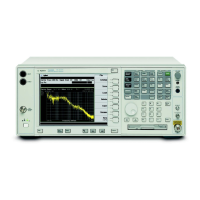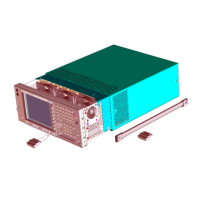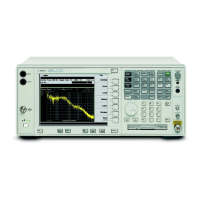
Do you have a question about the Agilent Technologies E4402B and is the answer not in the manual?
| Brand | Agilent Technologies |
|---|---|
| Model | E4402B |
| Category | Measuring Instruments |
| Language | English |
Explains safety symbols and their meanings for operating the instrument.
Details the warranty period, coverage, and service procedures for the instrument.
Details settings for channel power, occupied bandwidth, and ACP measurements.
Details settings for Multi-Carrier Power, Power Stat CCDF, Harmonic Distortion, Burst Power.
Details settings for Intermod (TOI), Spurious Emissions, and Spectrum Emission Mask.
Lists available measurement functions like Channel Power, ACP, and Harmonic Distortion.
Lists front-panel keys alphabetically with their corresponding page numbers.
Continues the alphabetical listing of front-panel keys and their page numbers.
Continues the alphabetical listing of front-panel keys and their page numbers.
Continues the alphabetical listing of front-panel keys and their page numbers.
Continues the alphabetical listing of front-panel keys and their page numbers.
Continues the alphabetical listing of front-panel keys and their page numbers.
Continues the alphabetical listing of front-panel keys and their page numbers.
Continues the alphabetical listing of front-panel keys and their page numbers.
Explains how AMPLITUDE Y Scale activates reference level and amplitude menu keys.
Explains scale type (Log/Lin) and preselector center/adjust settings.
Covers reference level offset, internal preamp control, and applying corrections.
Details antenna correction settings and how to edit correction factors.
Explains how to enter frequency and amplitude values for correction points.
Covers deleting correction points and entire correction sets.
Explains entering amplitude values and deleting correction points for user factors.
Details user correction factors and deletion of correction sets.
Details settings for maximum mixer level and IF gain auto/fixed modes.
Explains how Auto Couple links functions and the effect of Auto All.
Details phase noise optimization and detector auto/manual selection.
Explains different detector modes (Peak, Sample, Negative Peak) and auto selection logic.
Describes Average, Peak, and Sample detection modes and their display indicators.
Explains Negative Peak detection and the Avg Type selection for averaging.
Details center frequency, start/stop frequencies, and CF step settings.
Details input impedance and coupling settings.
Covers amplitude reference signals and input mixer configurations.
Explains signal identification algorithms to aid in detecting multiple/image responses.
Details signal identification modes and mixer configuration options.
Covers selecting mixer type and adjusting mixer bias for external mixers.
Explains how to select markers and activate normal marker mode.
Details delta marker functionality and span pair adjustments.
Covers turning markers off, selecting markers, and changing marker readout.
Explains Band Power and Marker Noise functions for signal analysis.
Details Marker Noise accuracy considerations and the marker table function.
Details settings for Avg Number, Avg Mode, and Integration Bandwidth.
Covers channel power span settings and optimizing reference level.
Details Avg Number, Avg Mode, Max Hold, Occ BW % Pwr, and OBW Span.
Explains the x dB setting for emission bandwidth and measurement results display.
Details Avg Number, Avg Mode, and Channel Integration Bandwidth for ACP.
Covers offset/limits settings and measurement type selection for ACP.
Details Avg Number, Avg Mode, Limits, and Filter settings.
Covers second carrier offsets and configuring offsets/limits for MCP.
Details Meas BW, Counts, and Meas Interval settings for CCDF.
Covers Avg Number, Avg Mode, Harmonics, and ST/Harmonic settings.
Details Avg Number, Avg Mode, Avg Type, and Threshold Level settings.
Covers burst width settings and measurement methods for Burst Power.
Details Avg Number, Avg Mode, and TOI Span settings.
Covers Avg Number, Avg Mode, and Range Table settings.
Details viewing spurs and setting reference level.
Covers Avg Number, Meas Type, and Ref Channel settings.
Details fail mask logic and optimizing reference level for SEM.
Lists available measurements like Channel Power, Occupied BW, and ACP.
Explains Channel Power calculation and Occupied BW measurement details.
Covers ACP, MCP, and Power Stat CCDF measurement descriptions.
Details the calculation for average power in CCDF measurements.
Explains the calculation of total harmonic distortion (%THD).
Describes the Burst Power measurement and its parameters.
Provides an example of Burst Power measurement results.
Covers descriptions for TOI, Spurious Emissions, and Spectrum Emission Mask.












